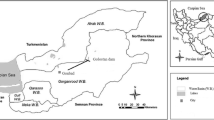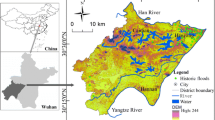Abstract
Watersheds are known as the most significant unit of flood management. Prior to the implementation of structural and/or non-structural flood mitigation measures, it is vital to prioritize the hydrological units based upon their potential for flooding. Yet, watershed prioritization is generally faced with such major methodological challenges as existence of multiple conflicting criteria, and difficulty of providing a balance between subjective and objective judgments. To overcome this issue, an integrated multiple criteria analysis (MCA) context, constituting Shannon’s Entropy and VIKOR, was creatively applied to prioritize Shemshak’s hydrological units located in Iran, according to their flooding potentials. Throughout the present study, Shannon’s Entropy technique was applied to select the evaluation criteria by consideration of subjective and objective weights of the criteria. Meanwhile, VIKOR determined the compromise solution from a set of alternatives based on the particular measure of closeness to the ideal solution. The proposed methodology included two different sorts of sensitivity analysis for investigating the impacts of criteria weights’ modifications on the final ranking. The proposed integrated MCA procedure made a valid contribution to the problem. With the aid of Shannon’s Entropy, the feature selection was done based on the experts’ view-points and intrinsic significance of the factors, simultaneously. VIKOR ranked the alternatives based on the maximum group utility of the majority and the minimum of the individual regret of the opponent. Furthermore, performing sensitivity analysis of the criteria weights illustrated the robustness of the decision making process. Overall, the highest priority of flood potential belonged to Sh2, the largest hydrological unit of Shemshak. Due to appropriate performance of proposed integrated MCA procedure, it could potentially be employed in different fields associated to the watershed management.

Similar content being viewed by others
References
Afzali A, Sabri RM, Samani JMV, Ludin ANM (2014) Inter-municipal landfill site selection using analytic network process. Water Resour Manag 28(8):2179–2194
Ahmadisharaf E, Kalyanapu AJ, Chung ES (2015) Evaluating the effects of inundation duration and velocity on selection of flood management alternatives using multi-criteria decision making. Water Resour Manag 29(8):2543–2561
Al-Abadi AM (2015) Modeling of groundwater productivity in northeastern Wasit Governorate, Iraq using frequency ratio and Shannon’s entropy models. Appl Water Sci. doi:10.1007/s13201-015-0283-1
Anderson DG (1970) Effects of urban development on floods in northern Virginia. US Government Printing Office
Anderson DR (1974) The national flood insurance program: problems and potential. J Risk Insur 41:579–600
Azarnivand A, Chitsaz N (2015) Adaptive policy-responses to water shortage mitigation in arid regions- a systematic approach based on eDPSIR, DEMATEL and MCDA. Environ Monit Assess 187(2):1–15. doi:10.1007/s10661-014-4225-4
Azarnivand A, Hashemi-Madani FS, Banihabib ME (2014) Extended fuzzy analytic hierarchy process approach in water and environmental management (case study: Lake Urmia Basin, Iran). Environ Earth Sci 73(1):13–26
Badoux A, Graf C, Rhyner J, Kuntner R, McArdell BW (2009) A debris-flow alarm system for the Alpine Illgraben catchment: design and performance. Nat Hazards 49(3):517–539
Boehm BW (1976) Improving software productivity, In Computer
Booth DB, Hartley D, Jackson R (2002) Forest cover impervious-surface area and the mitigation of stormwater impacts1. JAWRA J Am Water Resour Assoc 38(3):835–845
Brown CJ, Vearil J, Linton P, Hendren T, Whittle G (2014) A multi-criteria assessment of the C-111 hydrologic restoration project—a case study. Water Resour Manag 28(9):2453–2469
Browne MJ, Hoyt RE (2000) The demand for flood insurance: empirical evidence. J Risk Uncertain 20(3):291–306
Chang CL, Hsu CH (2009) Multi-criteria analysis via the VIKOR method for prioritizing land-use restraint strategies in the Tseng-Wen reservoir watershed. J Environ Manage 90(11):3226–3230
Chang CL, Hsu CH (2011) Applying a modified VIKOR method to classify land subdivisions according to watershed vulnerability. Water Resour Manag 25:301–309
Chang CL, Lin YT (2014) Using the VIKOR method to evaluate the design of a water quality monitoring network in a watershed. Int J Environ Sci Technol 8:303–310
Chargui S, Gharbi H, Slimani M (2013) Runoff responses at different watershed scales in semi arid region: exploration of a developed rainfall runoff model (Merguellil and Skhira watershed, Central Tunisia). Earth Sci Inf 6(3):127–136
Chung ES, Lee KS (2009) Identification of spatial ranking of hydrological vulnerability using multi-criteria decision making techniques: case study of Korea. Water Resour Manag 23(12):2395–2416
e Costa CAB, Da Silva PA, Correia FN (2004) Multicriteria evaluation of flood control measures: the case of Ribeira do Livramento. Water Resour Manag 18(3):263–283
Field CB (Ed.) (2012) Managing the risks of extreme events and disasters to advance climate change adaptation: special report of the intergovernmental panel on climate change. Cambridge University Press, 582 pp
Geng G, Wardlaw R (2013) Application of multi-criterion decision making analysis to integrated water resources management. Water Resour Manag 27(8):3191–3207
Goodhue DL, Quillard JA, Rockart JF (1988) Managing the data resource: a contingency perspective. MIS Q 12(2):373–392
Healthcote IW (1998) Integrated watershed management: principles and practice. Wiley, New York
Herron D (1976) Industrial engineering applications of ABC curves. AIIE Trans 8(2):210–218
Jaiswal RK, Thomas T, Galkate RV, Ghosh NC, Singh S (2014) Watershed prioritization using Saaty’s AHP based decision support for soil conservation measures. Water Resour Manag 28(2):475–494
Jozi SA, Shafiee M, Moradi-Majd N, Saffarian S (2012) An integrated Shannon's Entropy–TOPSIS methodology for environmental risk assessment of Helleh protected area in Iran. Environ Monit Assess 184(11):6913–6922
Juran JM (2004) Juran, quality, and a century of development, the Non-Pareto principle; Mea Culpa. American society for quality. USA: American Society for Quality, Quality Press
Kackar RN (1985) Off-line quality control, parameter design and the Taguchi method. J Qual Technol 17:176–188
Karamouz M, Nazif S (2013) Reliability-based flood management in urban watersheds considering climate change impacts. J Water Resour Plann Manag 139(5):520–523
Kaya T, Kahraman C (2011) Fuzzy multiple criteria forestry decision making based on an integrated VIKOR and AHP approach. Expert Syst Appl 38(6):7326–7333
Kim Y, Chung ES (2013) Fuzzy VIKOR approach for assessing the vulnerability of the water supply to climate change and variability in South Korea. Appl Math Model 37(22):9419–9430
Kim Y, Chung ES, Jun SM (2015) Iterative framework for robust reclaimed wastewater allocation in a changing environment using multi-criteria decision making. Water Resour Manag 29(2):295–311
Kuhn H, Tucker AW (1951) Nonlinear programming. In: Neyman J (ed) Proceedings of the second Berkeley symposium on mathematical statistics and probability. University of California Press, Berkeley, pp 481–492
Langhammer J (2010) Analysis of the relationship between the stream regulations and the geomorphologic effects of floods. Nat Hazards 54(1):121–139
Machiwal D, Jha MK, Mal BC (2011) Assessment of groundwater potential in a semi-arid region of India using remote sensing, GIS and MCDM techniques. Water Resour Manag 25(5):1359–1386
Min SK, Zhang X, Zwiers FW, Friederichs P, Hense A (2009) Signal detectability in extreme precipitation changes assessed from twentieth century climate simulations. Climate Dynam 32(1):95–111
Ministry of Jihad-e-Agriculture (2010) Detailed Watershed Management Plan of Shemshak Watershed. (In Persian)
Mohammadpour O, Hassanzadeh Y, Khodadadi A, Saghafian B (2014) Selecting the best flood flow frequency model using multi-criteria group decision-making. Water Resour Manag 28(12):3957–3974
Mukhopadhyay B, Khan A (2015) Boltzmann–Shannon entropy and river flow stability within Upper Indus Basin in a changing climate. Int J River Basin Manag 13(1):87–95
Opricovic S (1998) Multicriteria optimization of civil engineering systems. Faculty of Civil Engineering, Belgrade
Opricovic S, Tzeng GH (2004) The compromise solution by MCDM methods: a comparative analysis of VIKOR and TOPSIS. Eur J Oper Res 156(2):445–455
Opricovic S, Tzeng GH (2007) Extended VIKOR method in comparison with outranking methods. Eur J Oper Res 178(2):514–529
Pareto V (1909) Manuale d’Economia Politica. English translation, Kelly AM, 1971
Pilgrim DH (1977) Isochrones of travel time and distribution of flood storage from a tracer study on a small watershed. Water Resour Res 13(3):587–595
Pourebrahim S, Hadipour M, Mokhtar MB, Taghavi S (2014) Application of VIKOR and fuzzy AHP for conservation priority assessment in coastal areas: Case of Khuzestan district, Iran. Ocean Coast Manag 98:20–26
Raju KS, Kumar DN (2006) Ranking irrigation planning alternatives using data envelopment analysis. Water Resour Manag 20(4):553–566
Roughani M, Ghafouri M, Tabatabaei M (2007) An innovative methodology for the prioritization of sub-catchments for flood control. Int J Appl Earth Obs Geoinf 9:79–87
Roy B, Słowinski R (2013) Questions guiding the choice of a multicriteria decision aiding method. EURO J Decis Process 1:69–97
Shannon CE, Weaver W (1947) The mathematical theory of communication. The University of Illinois Press, Urbana
Shemshadi A, Shirazi H, Toreihi M, Tarokh MJ (2011) A fuzzy VIKOR method for supplier selection based on entropy measure for objective weighting. Expert Syst Appl 38:12160–12167
Singh VP, Oh J (2015) A Tsallis entropy-based redundancy measure for water distribution networks. Physica A Stat Mech Appl 421:360–376
Sohail A, Watanabe K, Takeuchi S (2008) Runoff analysis for a small watershed of Tono Area Japan by back propagation artificial neural network with seasonal data. Water Resour Manag 22(1):1–22
Sudhira HS, Ramachandra TV, Jagadish KS (2004) Urban sprawl: Metrics, dynamics and modelling using GIS. Int J Appl Earth Obs Geoinf 5:29–39
Theil H (1972) Statistical decomposition analysis. North-Holland Publishing Company, Amsterdam
Tong LI, Chen CC, Wang CH (2007) Optimization of multi-response processes using the VIKOR method. Int J Adv Manuf Technol 31:1049–1057
Voevodin AF, Nikiforovskaya VS, Ostapenko VV (2008) Mathematical modeling of transformation of flood waves in stream channels with floodplains. Russ Meteorol Hydrol 33(3):193–198
Wang TC, Lee HD (2009) Developing a fuzzy TOPSIS approach based on subjective weights and objective weights. Expert Syst Appl 36:8980–8985
Yazdi J, Salehi-Neyshabouri SAA (2014) Identifying low impact development strategies for flood mitigation using a fuzzy-probabilistic approach. Environ Model Software 60:31–44
Yu X, Meuwissen THE (2011) Using the Pareto principle in genome-wide breeding value estimation. Genet Sel Evol. doi:10.1186/1297-9686-43-35
Yue S, Ouarda TBMJ, Bobée B, Legendre P, Bruneau P (1999) The Gumbel mixed model for flood frequency analysis. J Hydrol 226(1):88–100
Yufeng S, Fengxiang J (2009) Landslide stability analysis based on generalized information entropy. In Environmental Science and Information Application Technology, 2009. ESIAT 2009. Int Conf IEEE 2:83–85
Ziervogel G, Downing TE (2004) Stakeholder networks: improving seasonal climate forecasts. Clim Chang 65:73–101
Acknowledgments
We appreciate insightful and constructive comments and suggestions by two anonymous reviewers and respectable associate editor.
Author information
Authors and Affiliations
Corresponding author
Ethics declarations
Conflict of Interest
The authors declare that they have no conflict of interest.
Appendix
Appendix
1.1 Gravelious Compactness Coefficient
where P is the perimeter of the watershed and A is its area.
1.2 Hydrologic form Coefficient
where P is the perimeter of the watershed and A is its area.
1.3 Length (La) and Width (Wa) of Equivalent Rectangular
where P is the perimeter of the watershed, A is its area, and Cc the Gravelious compactness coefficient.
1.4 Drainage Density
where Li is the length of each stream in the watershed, and A is its area.
1.5 Potential Flood Coefficient
where Q T is the discharge for a return period, and A is its area.
Rights and permissions
About this article
Cite this article
Malekian, A., Azarnivand, A. Application of Integrated Shannon’s Entropy and VIKOR Techniques in Prioritization of Flood Risk in the Shemshak Watershed, Iran. Water Resour Manage 30, 409–425 (2016). https://doi.org/10.1007/s11269-015-1169-6
Received:
Accepted:
Published:
Issue Date:
DOI: https://doi.org/10.1007/s11269-015-1169-6




